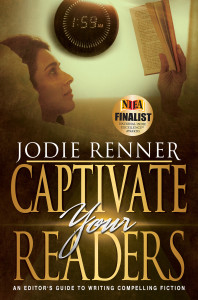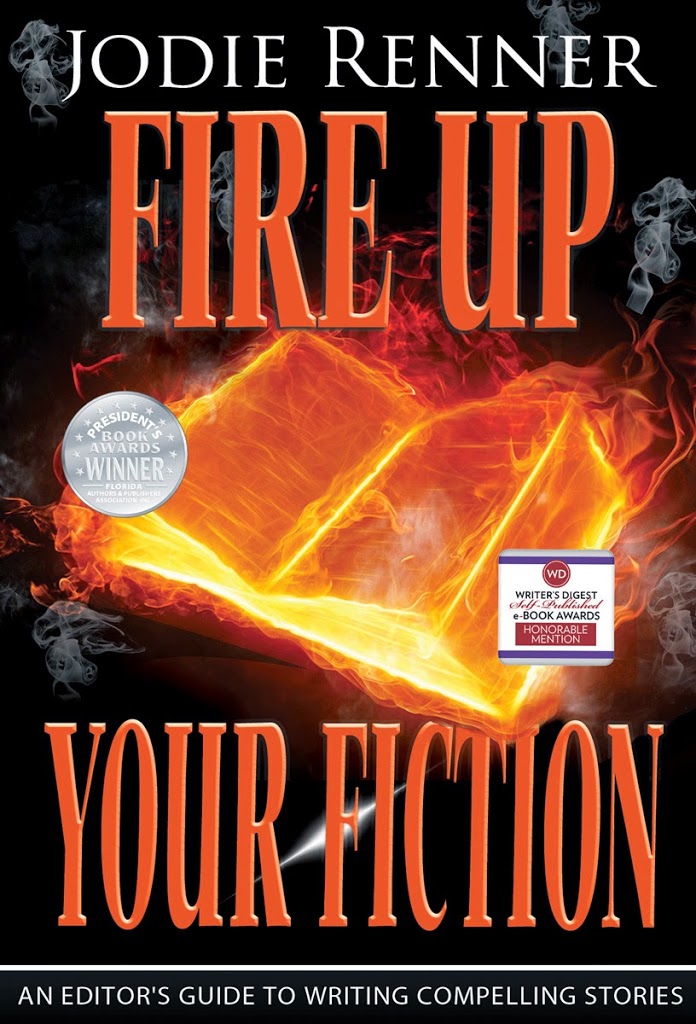 by Jodie Renner, editor & author @JodieRennerEd
by Jodie Renner, editor & author @JodieRennerEd
This is the first of a three-part series on point of view (POV) in fiction.
I’ve been editing fiction for years, and the most difficult concept for many of my aspiring author clients who write in third-person point of view (the most common POV in novels) is to portray their story world through the viewpoint / eyes / head of one character at a time, rather than hovering above them (omniscient POV) or ping-ponging back and forth between different characters’ viewpoints (head-hopping).
Except for omniscient POV (the author talking directly to the readers), point of view or POV simply refers to the character through whose perspective the story events are told. Most of today’s novels are written in third-person POV, with the main character referred to as “he” or
“she,” even though we’re seeing their world through their eyes. First-person POV, where the main character is telling their own story, using “I” and “me” seems to be gaining popularity, and is very common in YA (young adult) fiction.
This post is about using close third person or deep point of view to bring your main character to life for the readers. Ideally, we should only see, hear, smell, feel, and experience events as that character would – with no additional information provided “from above” by the author. This closeness helps your readers get to know your viewpoint character intimately, which makes them start worrying about him or her – and that keeps them turning the pages!
A hundred years ago, novels were often told from a distant authorial point of view, hovering over everything. That omniscient POV is no longer popular today (except for historical sagas), and for good reason: Readers want to experience the events of the story vicariously through the viewpoint character, to immerse themselves in her world, and they can only do that if they’re “inside her skin,” so to speak. They know/feel her inner thoughts, insecurities, hopes, and fears, so they bond with her quickly and are eager to find out what’s going to happen to her next and how she’s going to handle it.
As the late, great Jack M. Bickham said, “You’ll never have problems with the technique of viewpoint again if you simply follow this advice:
“Figure out whose story it is. Get inside that character—and stay there.”
It’s especially important to open your book in your protagonist’s point of view, and stay there for at least the first chapter. This gives the reader a chance to figure out quickly whose story this is, and get to know him fast and start identifying with him and rooting for him.
Years ago I edited a novel in which a 15-year-old girl is riding in a car with her mother, who’s driving, and her 11-year-old brother in the backseat. (I’ve changed the details a bit.) The book starts out in the point of view of the mom, who is worried about uprooting her two kids and moving across the country, away from their friends. So we start empathizing with the mother, thinking it’s her story.
Then suddenly we’re in the head of the teenage girl beside her, who is deeply resentful at her mom for tearing her away from her friends and is agonizing over what lies ahead. Then, all within the first page, we switch to the head of the 11-year-old boy, who’s excited about the new adventure and wishes his sister would lighten up and quit hassling the mom. We’re also in his visual POV – he looks at his sister’s ponytail and considers yanking it. Now we’re confused. Whose story is this, anyway? Who are we supposed to be most identifying with and bonding with? Readers want to know this right away, so they can sit back and relax and enjoy the ride.
It’s essential to start out the story in your protagonist’s POV, but it’s also smart to tell most of your story from your main character’s viewpoint – at least 70 percent of it. That gets the reader deeper and deeper into that person’s psyche, so they get more and more invested in what’s happening to her.
As Bickham explains, “I’m sure you realize why fiction is told from a viewpoint, a character inside the story. It’s because each of us lives our real life from a single viewpoint – our own – and none other, ever.”
Successful fiction writers want their story to be as convincing and lifelike as possible, so they write it like we experience real life: from one viewpoint (at a time) inside the action.
So if you want your lead character to come alive and matter to the reader, and your story to be compelling, it’s best to show most of the action from inside the head and heart of your protagonist. Of course, thrillers often jump to the POV of the villain, to add suspense, worry, intrigue and dimension. But give the bad guy his own scene, and make sure he’s not onstage more than the protagonist is! And many romances have two main protagonists, the hero and heroine, but one usually predominates – most often the heroine, so the largely female readership can identify with her. Just don’t be inside the head of both characters in one scene – too jarring and confusing!
Also, if there’s a scene with your protagonist and a minor character, don’t show the scene from the POV of the minor character, unless there’s a very good reason for it – it’s just too unnatural and jarring.
In POV 102, I discuss “head-hopping,” a sure sign of amateurish writing, with a trick for spotting this in your writing; and in POV 103, I’ll get into more detail on deep point of view, or close third-person POV.
By the way, I presented two writing craft workshops at a conference two weeks ago, “Engage Your Readers with Deep Point of View” and “Spark up Your Stories – Adding Tension, Suspense, & Intrigue.” Here’s the HANDOUT for the Deep POV one. The handout for the other one is there, too, as well as a list of writers’ conferences and book festivals through July 2015.
 Jodie Renner is a freelance fiction editor and the award-winning author of three craft-of-writing guides in her series An Editor’s Guide to Writing Compelling Fiction: Captivate Your Readers, Fire up Your Fiction, and Writing a Killer Thriller. She has also published two clickable time-saving e-resources to date: Quick Clicks: Spelling List and Quick Clicks: Word Usage. You can find Jodie at www.JodieRenner.com, www.JodieRennerEditing.com, her blog, http://jodierennerediting.blogspot.com/, and on Facebook, Twitter, and Google+.
Jodie Renner is a freelance fiction editor and the award-winning author of three craft-of-writing guides in her series An Editor’s Guide to Writing Compelling Fiction: Captivate Your Readers, Fire up Your Fiction, and Writing a Killer Thriller. She has also published two clickable time-saving e-resources to date: Quick Clicks: Spelling List and Quick Clicks: Word Usage. You can find Jodie at www.JodieRenner.com, www.JodieRennerEditing.com, her blog, http://jodierennerediting.blogspot.com/, and on Facebook, Twitter, and Google+.


This is a great subject, Jodie. Thanks so much. You should put on a “retreat” up north there near your new home. I’ll drive up with my trailer, for sure. Now I’m off to my private retreat at Glacier for a week of editing in the clouds.
Thanks, Adam. Glad you find my advice helpful. And several people have suggested I host a writers’ retreat in the beautiful Okanagan Valley where I live now, with its lakes, low mountains, orchards, vineyards and world-class award-winning wineries! If I had a few clones, I’d definitely do that! 🙂
Head hopping is a common mistake for beginning writers. It’s best to have a space break between viewpoint shifts, and as you say, to stay within the head of a main character. Remember that this applies to descriptions as well. When a cop steps into a room, he’ll look for different details than a fashionista who will be examining what other women are wearing.
So true about the descriptions, Nancy! I get into that in POV 101 and 102. Stay tuned! 🙂
Jodie, what are your thoughts about the commonplace thriller opening which starts with a crime, and is not from the protag’s POV? I guess that wouldn’t work unless the story is written in multiple POVs, or the crime is witnessed by the protagonist.
Oops! My reply to Kathryn ended up further down. Sorry about that!
Jodie–
I know you would agree there’s room for alternatives. For instance, you say, “It’s especially important to open your book in your protagonist’s point of view….” True, if you’re Shakespeare writing Richard III, not true if you’re Shakespeare writing Hamlet. I seem to share the Bard’s second approach in my two published suspense novels. Neither begins with my main character’s POV. The idea is to first build suspense and curiosity. In The Dating Service, the prologue shows a body being uncovered by a bulldozer driver at a landfill. I hope the reader wants to know what that’s all about, but he already knows the driver isn’t going to figure in the rest of the novel. In the first chapter of The Anything Goes Girl, the action takes place on a desert island, and the POV character dies. Here, too, I have the same hope of generating reader expectation.
But certainly the best odds are with the approach you recommend–keeping it simple and straightforward in regard to the central character. But that’s not necessarily right for certain stories or writers.
Thanks for your comments, Barry. In your first example, I think that would work very well, as readers will know that body isn’t the protagonist.
In your second example, I think you run the risk of readers thinking this character on the island is the main character who’s going to stick around through the whole novel, so they start identifying with her and bond with her, then, when she gets killed off, they could feel manipulated and cheated. But it’s all in your approach, really, so I’m going to assume that in your case, it works, and readers don’t feel angry when this person dies and they have to start rooting for someone else instead.
I’ll have to read your novels! 🙂
Jodie–I didn’t make myself clear, sorry. The book’s title–The Anything Goes Girl–along with cover info, etc should make clear to my readers that the main character is a young woman journalist. The character who dies is a man, and his death will be the catalyst for much of the action. The woman journalist makes her first appearance immediately after the opening.
Kathryn, I’m just not crazy about that opening, especially if it’s particularly violent, which can be a real turn-off for some readers, myself included. I need to work up to violent scenes, with a bit of forewarning. Don’t douse me in pain and bloodshed as soon as I open the book!
Most thriller writers do use multiple POVs, with the villain getting his own POV, which is very effective. And some do start out with the murder occurring. That’s a choice, but one I’m personally not crazy about. If authors do do that, they should get us into the head of the protagonist right away after that, and stay there for at least a chapter, so readers get to know him/her and know who to root for.
Just emailed one of my workshop students from Michigan with a link to this, Jodie. He was struggling with head-jumping and what “intimate” third person POV was. This will help him.
Thanks, Kris. I present a 50-minute workshop called “Engage Your Readers with Deep Point of View” (could be longer or shorter), if anyone is interested in having me present it at their conference or writers’ group. I give lots of concrete examples and ask the participants what’s wrong in each instance.
Jodie –
A most worthy topic imo. As a reader I find “synching” with a character’s POV the necessary but not sufficient step for engagement.
Communication/understanding of antagonist’s and others world view often underlies the credibility of story developments.
These are excellent guidelines.
Of course some can work the high-wire blindfolded and without a net yet never falter. I’m reading James Lee Burke’s “Wayfaring Stranger” and rarely get more than a few pages without wondering how he is renders story and characters so vividly that the story is alive and the characters’ feelings visceral and true. (Yep longtime TKZers – another TC rave about JLB)
Deep POV is definitely an element of his genius.
Great post!
Thanks, Tom. I recently started a John Grisham book and in the first page he was bouncing back between two different characters’ thoughts, perceptions, and observations. It was very confusing to me, and since it was so early in the book, I was left wondering which of these characters I was supposed to be identifying with, whose story it basically was, who I’m supposed to be rooting for. I put the book down and haven’t picked it up again.
James Lee Burke is definitely a gifted writer! I believe it was you who introduced me to him… Thanks for that!
I get into the rationale for advocating deep point of view in my upcoming third book, but it’s mainly about drawing the reader in my having us almost “become” the main character for the duration of the novel. That makes us worry about him to the point that it’s very hard to put the novel down. That should be the result of deep POV well done.